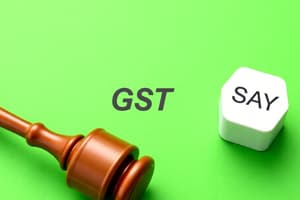Podcast
Questions and Answers
What is the GST threshold for businesses in hilly states like Arunachal Pradesh?
What is the GST threshold for businesses in hilly states like Arunachal Pradesh?
- ₹20 lakhs
- ₹5 lakhs
- ₹10 lakhs (correct)
- ₹1 lakh
Which of the following is NOT a type of GST?
Which of the following is NOT a type of GST?
- UTGST
- SGST
- IGST (correct)
- CGST
Which of the following is TRUE about the GST Council?
Which of the following is TRUE about the GST Council?
- The GST Council has 33 members, including Union Finance Ministers and State Finance Ministers. (correct)
- The GST Council consists only of state Finance Ministers.
- The GST Council determines the salaries of government employees.
- The GST Council is responsible for setting the interest rates for loans.
What is the GST rate for most items in India?
What is the GST rate for most items in India?
Which of the following goods is NOT subject to GST in India?
Which of the following goods is NOT subject to GST in India?
What is the purpose of GST return filing?
What is the purpose of GST return filing?
Which of the following is an example of Input GST?
Which of the following is an example of Input GST?
What does GST stand for?
What does GST stand for?
Which of the following provisions is NOT covered under Article 279 of the Constitution of India?
Which of the following provisions is NOT covered under Article 279 of the Constitution of India?
What is the main goal of the GST system in India?
What is the main goal of the GST system in India?
The GST Council is responsible for which of the following?
The GST Council is responsible for which of the following?
What is the significance of the Kelkar Committee in the context of GST?
What is the significance of the Kelkar Committee in the context of GST?
Flashcards
Output GST
Output GST
GST collected on sales of goods and services.
Input GST
Input GST
GST paid on purchases that businesses can deduct from Output GST.
GST Bill Introduction
GST Bill Introduction
The 122nd constitutional amendment bill introduced for GST in India.
GST Council
GST Council
Signup and view all the flashcards
GST Implementation Date
GST Implementation Date
Signup and view all the flashcards
GST
GST
Signup and view all the flashcards
Types of GST
Types of GST
Signup and view all the flashcards
CGST
CGST
Signup and view all the flashcards
SGST
SGST
Signup and view all the flashcards
IGST
IGST
Signup and view all the flashcards
GST Rate Slabs
GST Rate Slabs
Signup and view all the flashcards
Study Notes
GST: A Comprehensive Overview
- GST is an indirect tax replacing excise duty, service tax, and sales tax.
- It aims for a "One Nation One Tax" system, simplifying Indian taxation.
- GST is levied on goods and services, unlike direct taxes.
- Businesses with annual turnover exceeding ₹20 lakhs must register for GST, regardless of profit.
- GST covers online commerce, even transactions as low as ₹10.
- Hilly states like Arunachal Pradesh have a lower GST registration threshold of ₹10 lakhs.
Types of GST
- Four types exist: CGST, SGST, UTGST, and IGST.
- CGST is levied by the Central Government within a state.
- SGST is levied by the State Government within a state.
- UTGST is levied by Union Territory Governments within their territories.
- IGST applies to inter-state movement of goods/services.
- IGST combines CGST and SGST, facilitating interstate trade.
GST in India: Key Points
- The GST Council, chaired by the Union Finance Minister, oversees implementation.
- The GST Council sets rate slabs, structure, and policies.
- The GST Council comprises 33 members: 1 Union Finance Minister, 1 Union Minister of State for Finance, 28 State Finance Ministers, and 3 Union Territory Finance Ministers (Delhi, Jammu and Kashmir, and Puducherry).
- GST rate slabs are 0%, 5%, 12%, 18%, and 28%, balancing essential and luxury items.
- GST applies to automobiles, cement, perfume, conditioners, motorcycles, and diverse goods/services.
- The majority of items fall into the 18% slab for GST.
GST Return Filing
- Monthly GST returns are due every 10 days.
- GST returns report collected and paid GST, filed online.
- GST filing ensures system accuracy and compliance.
Output and Input GST
- Input GST: GST paid on business purchases.
- Output GST: GST collected on business sales.
- Businesses deduct Input GST from Output GST to determine net payable GST.
- GST returns track both Input and Output GST.
GST: Its Impact
- GST aims for nationwide tax standardization, promoting interstate trade and reducing business burdens.
- It simplifies the tax system for businesses and consumers.
- GST aims for a more transparent and efficient tax system.
Introduction of GST in India
- The GST Bill was introduced as the 122nd constitutional amendment bill.
- GST legislation passed in 2016, as the 101st Amendment to the Constitution of India.
- GST was implemented across India on July 1, 2017.
- The system was developed per Kelkar Committee recommendations.
- The GST model is inspired by the Canadian Goods and Services Tax system.
GST: Key Provisions & Regulations
- GST return filing is mandatory for all registered taxpayers.
- Non-filing incurs penalties, including fines and up to 5 years imprisonment.
- The GST Council is the governing body for GST in India.
- GST is covered under Article 269 of the Constitution of India, governing tax revenue distribution.
- The GST Council is established under Article 279 of the Constitution.
Studying That Suits You
Use AI to generate personalized quizzes and flashcards to suit your learning preferences.




